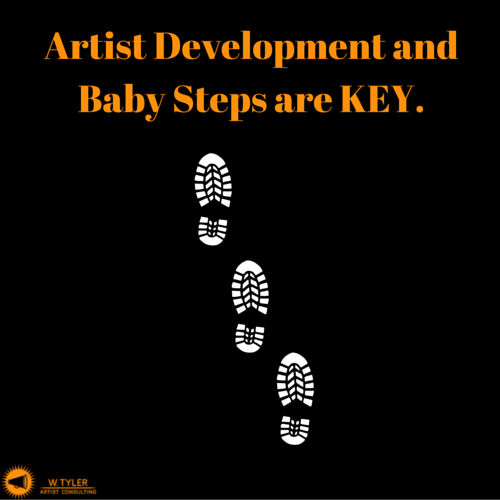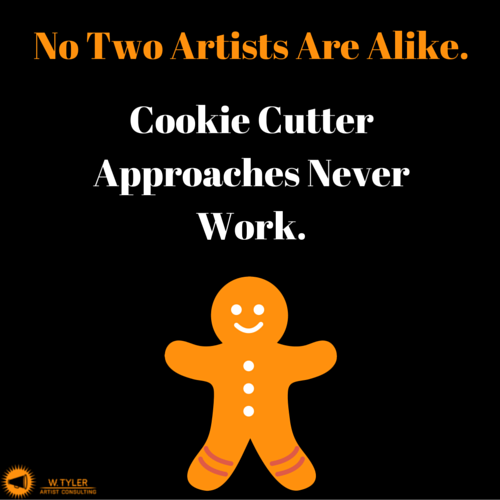What I Learned Working At A Record Label That Failed
Why do some record labels fail while others succeed? We explore what can be learned from watching a record label go under even after a promising start, and how such knowledge can be used to help other labels avoid similar pitfalls in the future.
______________________________________
By W. Tyler Allen on W. Tyler Consulting
In early 2015, I was invited to join a “dream team” of music industry professionals.
This team consisted of a former VP of a major record label, a manager from a “major” indie artist, as well as an assembly of top-notch graphic designers, publicists and assistants. Our mission was to work with a brand new record label, and assist them in acquiring a larger fanbase and overall develop their brand.
From the surface we succeeded: Social media numbers skyrocketed, we garnered healthy press coverage, and we even had two of their artist chart on radio. Not to mention, we had some official showcases, as well some fun opening spots.
However, despite this, the label ended up folding. Some of their (very talented) roster still operates with them, but what I assume is just until their contracts expire, or they recoup their recording costs.
So, how did this happen? They had the talent, a good team, and not to mention the capital, so… what happened? And more importantly, what can artists, labels and managers learn from this?
The New Artists Were Treated Like Vets.
Their artists were talented, very talented. One issue I found was that the label wanted myself and my team to completely take over the artist’s social media channels. However, they weren’t ready developmentally for a team to just completely take over their brand and social media.
Come to think of it, even my major artist clients don’t have a team handling their social completely. You might have someone schedule certain portions of content or maybe offer an extra set of hands during a tour, but for the most part, as an artist, you need to showcase your brand online.
Especially when that brand is still being developed.
This led to the artists feeling as if the label wasn’t “portraying their brand” appropriately online. They felt as if tweets went out in a tone that wasn’t “their voice”. And well, yeah — because it wasn’t their voice. Their brand was still too green for someone else to handle it.
These guys were still finding their voice as an artist, so they needed to tweet, do videos and interact on their own. Because they were still growing.
In today’s digital era, your online footprint — your imagery, your tweets, your ‘gram posts — are just as important as your music. You can have a dope track that’s getting radio play, but if your fans aren’t sharing it online, then its going to just fizzle out. You can have a team help you out with this, I recommend it, but handing it off completely to a third party — is a bit dangerous.
But social media really wasn’t the problem…
We did well on social media. The pages grew, and we got some great online traction during releases. However, when an artist doesn’t feel as if they have control of their art — the energy stops. You don’t need this, especially from a young artist. I already spoke on how the artist is the CEO, even with a label. You certainly don’t want “too many chefs in the kitchen” spoiling this. You need to give your artist’s room to grow.
However, let’s also talk about this from a growth standpoint. One of the guys on the “consultant team” was an industry vet of 30+ years or so. He’s also the manager of an artist that’s been the indie king, before indie was practical. He’d often gruff that our artists haven’t “paid their dues” yet.
And while that may seem like something any vet would say to a rookie — it’s actually a valuable piece of insight.
By putting a new artist on a pedestal, you’re selling the artist a lifestyle that might not actually come into fruition. The artist needs to be spending time networking, and remaining active on social media — rather than thinking: “The team will handle it”.
This is a major way to set an artist up for failure — by giving them illusions that they’re on the road to success, when their brand still hasn’t matured.
This was ridiculously summarized one week when we were on the road. The artists went out to a few clubs the night before a key performance. The label’s “A&R” pushed them to go, labeling it as “networking”. But in reality, it was just an excuse for them to stay out all night. Did they network? Maybe. But I do know that the only thing to come from their “network outing” was two artists oversleeping, with hoarse voices the day of their major showcase.
Another quick observation was the naivety that a track was going to go viral on it’s own — or the fact that we’d have thousands of pre-orders for these relatively known artists. Sure, the artist is good — and might be popping in your backyard, but we have to ensure that we have a working platform before we can expect to see massive results and brand awareness.
We Confused Movement with Progress
I want to be very clear about the dynamic of this partnership, and the dynamic of any client-agency relationship. It’s your duty to tell your client what their doing a bad idea. In this circumstance, the CEO of the label hired us because he was rather green when it came to the music industry.
However, the CEO would often go against our advice, a lot of this centered around pay-for-play.
The CEO wanted to ensure the artists saw movement, he wanted his artists satisfied because they were playing “during” SXSW, they were being posted on blogs, or they were opening for acts. While this is true, you need to keep your artists happy with movement, that movement isn’t always progress.
We bought onto gigs, which was a great experience for the artist — but didn’t really result in new fans or even moved merch. Especially when the line-up was jampacked with other folks who paid to play.
We paid to get onto blogs, which the artist thought was cool, but at the end of the day they were mid-tier and some top blogs, who rarely even shared the article on their social outlets. It was found on the website sure — but it wasn’t on the main page, or on their social media. So, who saw it? Aside from the fans we shared it with.
And yes, we boosted on social and more, but the key to PR is to make connections with journalists, not pay to be on a blog that isn’t even promoting their own article.
Similarly, why spend money on paying for shows, when you could be spending time pitching talent buyers and building relationships with venues. Or even spending time genuinely connecting with other bands, so those other artists invite you on as an open act. Organically. Without paying a dime.
One thing we did well was radio. Our guys were great on the microphone, and we had them on the road, going to stations spinning their work to do interviews. This led to more airplay, and it even led to a few music festival opportunities. Did it cost money to send them across the country doing press? Yes. But did it result in more authentic reach? Yep.
Our radio campaign was a great example of using leverage, to further a message. While, all of the paid work, was us moving without progression.
I guess I should also note that we likely relied too heavily on a radio promoter. After some time, we should have stopped outsourcing it, and brought the radio promotion in-house. Since we were already making connections, and we already sunk a pretty penny into the artists radio campaigns. This could have simply been us paying too much for a promoter, rather than a bad marketing move.
Watching a promising label sink a lot of money into pay-for-play, and pay-for-post opportunities, to the point that they were hurting financially, is why I’m such a vocal component of authentic PR and booking strategies.
However, we wanted to move. The wheels were spinning, but we weren’t really going anywhere.
The key here is leverage.
If you get a blog post, that blog post better be posted on the outlet’s social media, and be a genuine write-up, not just a copy and paste.
If you open up for an artist, there needs to be good marketing via the venue, and you need to ensure you’ll have a chance to connect with fans and move merch.
Sure, you can move, but you have to grow and progress as well. Simple movement isn’t enough, you need to go somewhere. Not just turn your wheels.
In this case, the CEO was paying big money to move our wheels — which later led to the label’s demise.
We Tried Using a Cookie Cutter Approach
The label had four prominent artists: One was an R&B act, two were rappers , and lastly, the label had an indie rock group, to round things out.
While the label kept pushing to use one marketing approach for all artists, you simply cannot use a “copy/paste” view when looking at these three artists. For instance, one could think you can lump the R&B artists and two rappers into one category, however, not so much.
The R&B artist was young and still really appealed to the 13-17 year old demographic. Whereas the two rappers had lyrical content that mainly dealt with sex, drugs and partying.
But even the two rappers were incredibly different — one was more of a lyricist, who had a very “mainstream” vibe to him. While the other had more of a rough image, a focus on production and had lyrical content that was a bit more “in your face” than the other rapper.
Despite having these very different artists, the label insisted they be booked at the same showcases, which, weren’t too bad. Until you remember, oh damn, they had an indie rock band, too!
Yes, the indie rock group was scheduled to play at a hip hop showcase in Austin, Texas.
That’s the thing, the team had in-depth experience surrounding hip hop, and the indie rock group suffered from it. The group was also incredibly talented, and actually had the most fan interaction on the label. They also (since there was 4 of them) seemed to take a lot of marketing initiative on their own.
The booking issue also came to a head when they were trying to book the rapper, who had a radio single explicit about sex, to play a high school tour. Because it worked for the R&B singer. Luckily, we convinced them to not go that route.
But the differences are more nuanced than just booking decisions. For instance, even if the two rappers were both “hip hop artists” things such as radio stations, press outlets, and even advertising keywords were going to change.
The Artists Needed Development, Not Contracts.
I’m not a legal expert, and I tend to refer my clients to folks that know more about contracts than I do. However, I do know that an artist shouldn’t have to be held to ridiculously high recoup costs, when there isn’t really a platform yet.
The label seemed to have these artists under agreements that some may consider standard industry fare. However, the label was brand new!
The label/artist relationship is symbiotic. For the artist to make money, the artist has to recoup the money that the label invested. So if the label spends 15K on recording, then the artist won’t see any money until they recoup that 15K. That’s on both of the label and artist to work towards.
However, the label wasn’t at a place in which they had a system to make money, similarly, the artists weren’t at a place where they had popping fan bases who were willing to consistently buy an artist’s product. Sure, this seems a bit a Chicken-Egg situation, however, these artists didn’t need record label – bank loans, they needed to be taught how to carry themselves as artists. And instead of the label depending on the artists to really bring in revenue (miraculously), they needed to spend more time developing their booking, licensing and sales systems before signing various artists.
My team didn’t deal with the artist’s contracts, and more tried to get the label to a place in which they were profiting. However, this showed a naivety that exists in a lot of young labels. Folks think “if they build it, it’ll come” but… no, you have to build it well. You need a solid foundation and solid revenue strategy before signing on multiple artists.
As consultants, as labels, as managers, as publicists — we forget this simple fact that bares repeating:
We are assisting artists in promoting their creation. We are helping an artist bring light to their art.
There’s nothing sexy or cool about this — actually, it’s a lot of pressure. You’re ensuring that you are framing, protecting and promoting an artist’s vision. That’s heavy. Before you delve into any artist relationship, you need to ensure you are properly equipped to give them the spotlight that they deserve.
Concluding This.
The above four “reasons” were integral in this label failing, but at the end of the day — the major reason we failed was capital. If we were to have taken our time between each artist, we might still be trucking along on this. But we spent a lot of money turning wheels, and promoting our acts very quickly and rapidly.
Also, there was just a lot of foundational issues that still needed to be addressed and repaired. Those restorations could’ve taken quite some time.
But at the end of the day, despite the label folding, this was one of the most memorable projects I have had the privilege of working on. The “dream team” of consultants have gone on to do many successful and fun projects, and the guys at the label I still have an incredible amount of respect for. Not to mention these artists are still incredible musicians, and I’m sure they’ll find ways to succeed and prosper very soon.
As a music marketing strategist, Tyler Allen works with an extensive array of artists, labels, music tech, and music retail entities. Tyler began his music industry career with Sony Music Entertainment and RED Distribution, as well as the advertising industry. He is dedicated to giving veteran artists the tools to preserve their legacy, and new artists the tools to begin theirs (as well as everything in between). Learn more at wtylerconsulting.com.




Evening Mr Tyler bless you I can feel your pain now am adding you and To make you stand on your own as a Billionare so all Artists can come under ya.
Hypebot – PLEASE hire someone to proof these articles – this piece is RIDDLED with typos and poor grammar. Makes it really difficult to read (or take seriously). C’mon.
Awesome insight.. definitely a must share with my listeners and bands we work with…